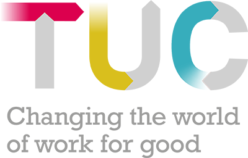As Covid-19 stopped mass gatherings in person this year, many unions had to make a choice whether to cancel their big conference events or to quickly rework long-running formats for a digital medium.
TUC Congress was adapted to work in a very different way, with a much smaller group of delegates. We ran a webinar on what we learned from this last month.
Two other large events that went digital in the weeks following Congress were NEU’s annual conference and the STUC Congress, which had been postponed from earlier in the year.
At the TUC Digital Lab we were joined for a webinar by Mike Joslin of NEU and Sarah Wiktorski of the STUC, sharing some of the tools they used and considerations they made in organising their events.
You can watch their presentations here:
With 2021’s union conference season still uncertain, many more unions will be making plans for their own online events. Here are a few takeaways from Mike and Sarah’s work.
Accessibility:
We’re used to making our physical conferences as accessible as we can, but once you break the boundaries of a physical event, it can open up participation to a much wider group. Sarah talked about how new groups of activists were able to take part in Congress this time, from locations all across Scotland, which previously might have excluded them.
And of course there are measures that can be taken to make the online events more accessible as well. Mike described NEU’s experiences with speech to text services Verbit.ai and Otter.ai, which have helped them to generate live subtitles on a less scripted format. STUC used a broadcast template to incorporate BSL interpreters on a live feed.
Voting:
Big events underpin union democracy, and both organisations had to find ways to enable voting to happen in a meaningful way – a logistical issue even with a reduced set of voting delegates.
There are two great and very different solutions here, with the STUC making imaginative use of third party services to cheaply create a system that met expectations and inspired confidence in delegates using it. NEU developed their own lightweight voting tool, called “NEU Democracy”, which allowed for complex weighted voting. This could be a useful solution for other unions to take up too – sharing the work NEU have done in getting this far with it.
Format changes:
Neither event was a direct copy of the physical event it replaced, but the medium offered opportunities as well as requiring compromises. For example, delegates were limited and the length of events reduced, but livestreaming let a wider group of people have a more casual relationship with the event, meaning more people overall tuned in.
There were also other ways to replicate the feeling of the event as well as the core business. A chat stream ran throughout STUC Congress, giving delegates who were dialling in from all over the chance to engage directly with each other – something that is a key benefit of physical union events.
Preparation is key:
Both events ran extensive training sessions in advance for delegates needing to know how they would speak and vote. There’s always a danger in assuming people will be able to work a new system on the day, but it’s doubly important when their initial engagement with this will be seen by hundreds of people live online.
As we did at TUC Congress, all speakers at STUC Congress got a practice call before the event, removing technical problems on the live feed and letting speakers make the most of their time on the day.

